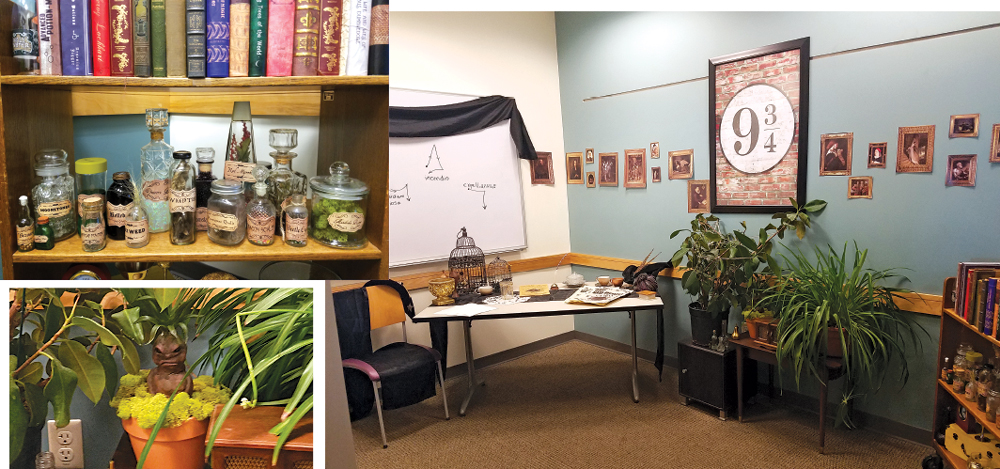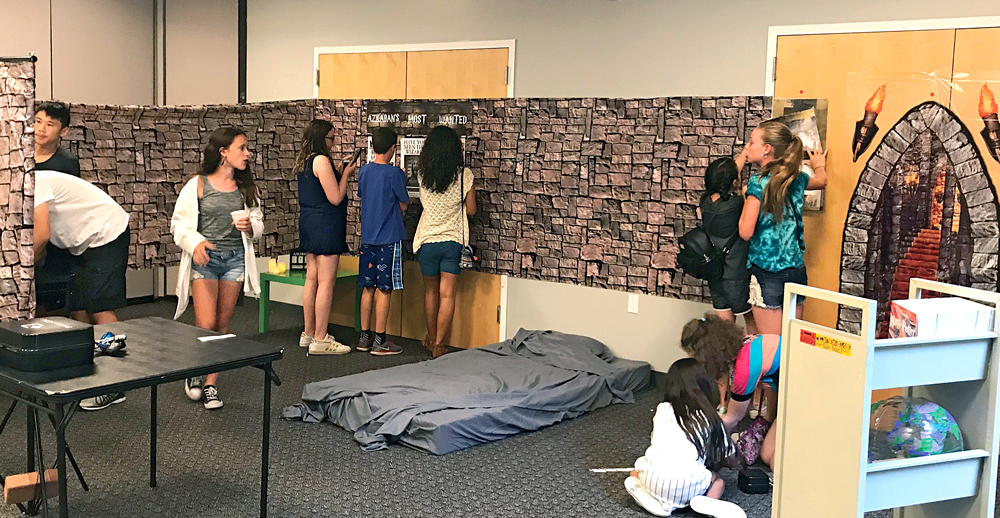Escape Wizards: Harry Potter-Themed Escape Rooms
Hogwarts, Horcruxes, and Hagrid are irresistible draws for escape room fans of all ages. Here's how librarians built their rooms.
 |
Clues and props at the Laramie County Library include books, potions, and a potted mandrake.Photos by Anna McClure/Courtesy of Laramie Public Library |
Robin Papaleka thought the program she created for the Laramie County Library in Cheyenne, WY, could be a hit, but she had doubts. Within an hour of announcing the event, they had evaporated.
Papaleka, along with fellow librarian Anna McClure, created a Harry Potter–themed escape room that she planned to run for two days. When they posted details online, every 30-minute slot quickly filled, and people were angry about being shut out.
Papaleka quickly decided to run the escape room for a full week, and slots for those were also booked during the first day.
“It was a bigger hit than we expected,” she says. “We had people coming all the way from Fort Collins,” a Colorado city about 45 miles south of Cheyenne. She says that combining two highly popular features—escape rooms and Harry Potter—attracts children and adults. (An earlier Star Trek–themed escape room wasn’t as big a draw.)
Papaleka and McClure are among a growing group of librarians tapping into the popularity of escape rooms, physical rooms where groups of players work together using clues and strategy to solve puzzles. The phenomenon started with for-profit rooms where customers pay about $30 each to be locked in a room together and try to puzzle their way out within a set time frame. In the past two years, the number of escape rooms nationwide has surged from 900 to 2,300.
Initially, the rooms were most popular among men in their late 20s to 30s, but the audience quickly expanded to include more women, families, and corporate groups, says David Spira, who with his wife, Lisa, runs RoomEscapeArtist.com, a website featuring reviews and news about various rooms across the country. Extending the trend to libraries and schools makes sense, he says, because the format allows “teachers to impart knowledge through a little bit of play.”
A Marauder’s Map, the Daily Prophet, and more
Papaleka created her Potter-themed room by putting pictures of the books’ characters on the walls and stocking a table with items such as the Marauder’s Map, a potion book, and some issues of the Daily Prophet. She also included an ominous-looking silver safe featuring a skull and crossbones. Players had to solve puzzles to pick up the necessary clues to open the safe. She added a black light to give the room a “cool” glow. Papaleka limited each group to four people, in part because the room was small.
Luisa Munoz, the teen librarian at the Merrick (NY) Library, decided to create her own program after visiting a commercial escape room in New York City. Munoz has run rooms with themes from a zombie apocalypse to Stranger Things.
For her Potter-themed room, Munoz ran two sessions with 10 teens each in her library’s multipurpose room, decorated with posters, lockboxes, and handwritten clues. She hid one clue inside a copy of Harry Potter and the Prisoner of Azkaban and put another on the back of a 50-piece puzzle players had to assemble. For her handwritten clues, she used invisible ink that players needed a black light flashlight to see.
While there isn’t data on how many schools and libraries are creating escape rooms, they appear to be on the rise. The trend is propelled in part by kits sold by Breakout EDU, which Munoz used to create her rooms. She used a kit with various locks from the immersive game company created by five former teachers. The company’s social platform is also an ideal place for educators to share ideas and success stories.
Adam Bellow, the CEO of Breakout EDU, says that while the company offers some themed games, it doesn’t provide anything specific to Harry Potter, because it hasn’t gained approval from the various licensees.
Commercial Harry Potter escape rooms have a dubious reputation within the community, Spira says, because they tend to get a lot of publicity when they open—and then they shut down quickly because of copyright concerns. As the escape room trend grows, expect to see more official themed escape rooms, he says, adding that games based on BBC’s Sherlock and the movie Ghostbusters are already being created.
Libraries and schools don’t face those copyright issues. They are free to create their own Harry Potter–themed escape rooms as long they don’t charge students or customers, says Lizette Serrano, executive director of educational marketing and event strategy at Scholastic’s Trade Division (the U.S. publisher of J.K. Rowling’s books). Meanwhile, Bellow says his company is working on creating a Stranger Things game in partnership with Netflix.
 |
A Prisoner of Azkaban–themed room at the Merrick Library.Photo courtesy of Luisa Munoz/Merrick Library |
Tips for a great escape room
Librarians are eager to share their tips, from planting red herrings to cost in time and money. Papaleka, Munoz, and Rachel Robinson, the young adult coordinator at the Northampton Area Public Library in Pennsylvania, agree that puzzles are the key to creating a challenging but fun experience. Papaleka used a map of Hogwarts, rune rocks, and Viktor Krum as some of her key clues.
Robinson also had participants put together a 50-piece puzzle and then turn the puzzle over to find their next prompt. She cleverly used Sirius Black’s prison number, 390, as a clue. She projected it onto the wall during the entire session, and many players initially missed its importance, she says. Munoz based her whole game on the Prisoner of Azkaban book, chronicling Potter’s third year at Hogwarts. She used a map, a sorting hat, and a book of monsters to test her players’ skills.
There are some basic differences between escape rooms where participants pay to play and those created for free by schools and libraries. Most professional rooms take an hour to complete, accept four to six players at one time, and sometimes aren’t solved by the participants. Library games typically take 20 to 45 minutes, can allow up to a dozen players at once, and are solved by most players. Munoz gives teams hints as they start to run out of time.
Luisa Munoz's best practices for creating a Potter-themed room.
The librarians estimated spending about $100 on the setup, mostly for decorations. While the room size varies by library, all say that small rooms are best, because they can be jammed with decorations and clues while encouraging players to interact more.
Typically, players who solve an escape room like to take a group photo at the end to commemorate their triumph. In Merrick, a staffer dressed like Hagrid offered a perfect tableau for selfies.
Papaleka suggests that fellow librarians make two of every prop in case they are damaged. Also, expect mishaps: One of Papaleka’s groups removed the pins from a safe to open it, thinking they were being clever rather than destructive. Setting aside 15 minutes in between teams allows the librarian to reset the room, she adds.
Red herrings can make a room harder and more fun to complete, says Munoz. She put a globe in her room as a decoration and was surprised when most teams spent time trying to figure out its importance.
Popular and fun, escape rooms can take months to set up. “It’s pretty exhausting, it takes a lot of staff hours,” says Papaleka. “We can’t do that real often.”
Still, it seems likely that more libraries and schools will get into the act. While Northampton ran its Harry Potter room a year ago, Robinson says she is still being asked when she is going to do another one.
Freelance journalist Wayne D’Orio has covered education nationally for more than 10 years.
RELATED
The job outlook in 2030: Librarians will be in demand
The job outlook in 2030: Librarians will be in demand
ALREADY A SUBSCRIBER? LOG IN
We are currently offering this content for free. Sign up now to activate your personal profile, where you can save articles for future viewing






Add Comment :-
Be the first reader to comment.
Comment Policy:
Comment should not be empty !!!